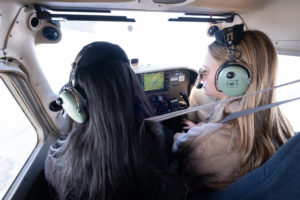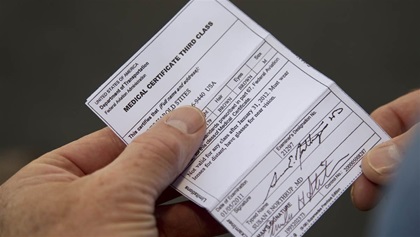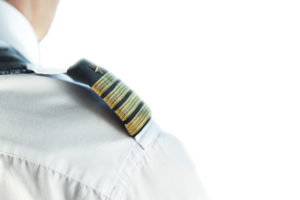For thousands of people, being a commercial airline pilot is their life-long dream. They want to soar above the clouds and see interesting places all over the world, all while being paid a high salary for it.
However, becoming a commercial airline pilot is no simple feat. It requires dedication, discipline, and hundreds of hours of training. For those who want to dip their toes into learning about what it takes to become a pilot, the F.A.R. Part 141 might be a better place to start. For those who are ready to dive fully into a commercial career path, know that it is a long path. But, at the end of the training you will find a rewarding job that you love.
Private Pilot Certification
 The first step in becoming a commercial airline pilot is to obtain your private pilot certificate. To clarify, this certificate is not referring to flying private jets commercially, think of it as the equivalent of needing a drivers license for a car. Having your private pilot certificate allows you to fly small aircraft recreationally. It does not give you the ability to be paid for flying.
The first step in becoming a commercial airline pilot is to obtain your private pilot certificate. To clarify, this certificate is not referring to flying private jets commercially, think of it as the equivalent of needing a drivers license for a car. Having your private pilot certificate allows you to fly small aircraft recreationally. It does not give you the ability to be paid for flying.
In order to be eligible to obtain your private pilot certificate you must be at least 17 years of age, proficient in English, and possess basic math skills. If you meet these requirements then you can begin the process of earning your private pilot certificate. This is not something that can be done in a matter of days, and will be a serious time commitment on your part. The steps you will need to complete are:
- Medical Exam – First things first, you will have to show that you are healthy enough to be behind the controls of an aircraft. You will need to be examined by an Aviation Medical Examiner who, if you are deemed in good health, will provide you with a third class medical certificate.

- Ground School – Before you can take off into the sky, you’ll need to learn the basics. This is done at ground school. You will be taught all of the basic knowledge and principles needed to successfully fly. This includes weather, aerodynamics, navigation, and flight planning. After you have completed your classes, you will need to pass a written exam administered by the FAA. It is a good idea to take the FAA practice test before attempting the real thing.
- Flight Training – Here’s what you’ll likely be the most excited for, finally getting into the cockpit. In flight training, an instructor will train you in every facet of flying, including day and night flying, cross-country flying, and various maneuvers. The FAA requires a minimum of 40 hours of flight training, but most students will require more than that before they are ready for the final test.
- CheckRide – Once you feel comfortable behind the controls (and your instructor agrees), you will have your final test, called a checkride, with an FAA examiner. They will test you on everything you’ve learned so far.
After successfully completing these steps, you will receive your private pilot certificate. While you’ll now be able to fly a plane recreationally by yourself, you’re only just starting your journey to becoming a commercial airline pilot.
Instrument Rating
Airlines don’t cancel flights just because it’s cloudy. That’s where instrument rating comes in. Instrument rating is a qualification that shows you have learned how to fly in cloudy or other low-visibility conditions. Having this qualification shows that you have the ability to pilot an aircraft solely by referencing the instrument panel, meaning you are not relying on what you are able to see through the windshield. An instrument rating qualification can be obtained as part of the F.A.R. Part 141 course.
Instrument Rating Requirements
In order to receive your instrument rating, there are a few requirements you must meet. These are:
- Proficiency with the English language.
- You must already have your private pilot certificate.
- Take ground training either in person from a flight instructor or through an online course.
- Receive an endorsement from a flight instructor stating that they believe you are capable of taking and passing the instrument rating knowledge test.
- Take and pass the instrument rating knowledge test.
- Take part in the required flight training.
Once you have passed the knowledge test and completed your flight training, you will receive your instrument rating. Having your instrument rating is a good idea even for non-commercial pilots, as it adds a layer of safety to flying in the event that visibility changes mid-flight.
Commercial Pilot Certificate
Now that you have your private pilot certificate and instrument rating, what’s next? The commercial pilot certificate. This will finally allow you to get paid for flying. However, earning this is a lot more difficult than earning your previous qualifications. To receive your commercial pilot certificate through F.A.R. Part 61, you will need:
- 250 hours of flight time. 100 of these hours are required to take place in powered aircraft, and 50 of these hours are required to be in airplanes.
- 100 hours of pilot-in-command time. 50 of these hours are required to be in an airplane.
- 50 hours of cross-country flight time. 10 of these hours are required to be in an airplane.
- 20 hours of training. 10 of these are instrument training and 10 are complex training.
- 10 hours of solo training. This includes night and cross-country training.
After these requirements are met, you can now legally be paid to fly. However, it should be noted that employers may require more hours than the FAA requires, so you may have to complete more flight hours before you can land a job. Also, having your commercial pilot certificate does not mean you can be an airline pilot. That requires your airline transport pilot certificate.
Want your commercial pilot certificate faster?
 Superior Flight School is one of the only schools in the United States that offers a condensed part 141 commercial course that allows you to get your commercial license in 43 hours. This excludes you from the 250 hour total time rule required through part 61. Because of this, you can save both time and money by choosing part 141.
Superior Flight School is one of the only schools in the United States that offers a condensed part 141 commercial course that allows you to get your commercial license in 43 hours. This excludes you from the 250 hour total time rule required through part 61. Because of this, you can save both time and money by choosing part 141.
Certified Flight Instructor (CFI)
Now that you can be paid to fly, a wise choice is to become a certified flight instructor (CFI). This allows you to reinforce the skills you have learned so far, while also getting more flight hours under your belt. To become a CFI, you must:
- Have your commercial pilot certificate.
- Receive an endorsement from a flight instructor on the fundamentals of instructing.
- Pass a knowledge test.
Anyone who wants to become a commercial airline pilot should make being a flight instructor their first pilot job. You will need a lot of flight hours to fly for an airline, and being a flight instructor allows you to rack up those hours while being paid for it.
Multi-Engine Rating
Up until this point in your training, you will likely have only flown single-engine planes. While this is impressive, being an airline pilot will require you to pilot a multi-engine plane. In order to do this, you will have to acquire your multi-engine rating, which qualifies you to fly planes with multiple engines.
Multi-Engine Rating Requirements
Fortunately for you, acquiring your multi-engine rating will not be so difficult once you already have your private pilot certificate. All you need to do is:
- Receive an endorsement from an instructor.
- Pass an additional check-ride with an FAA examiner in a multi-engine plane.
Once your check-ride is completed, you will be fully qualified to legally fly a multi-engine plane, and you will be one step closer to becoming a commercial airline pilot.
Airline Transport Pilot (ATP) Certificate
This is it, the final obstacle between you and taking to the sky as a commercial airline pilot. Once you have your ATP certificate, you will be able to start applying for jobs with airlines. However, of all the qualifications we have gone over so far, this one is the most difficult to acquire. In order to receive your ATP certificate, you must:
- Be at least 23 years of age.*
- Have your commercial pilot certificate.
- Have your instrument rating.
- Have proficiency in the English language.
- Hold a first class medical certificate to be pilot-in-command, or a second class medical certificate to be second-in command.
- Log 1500 hours of flight time.
- Complete an ATP training program.
- Take and pass the ATP knowledge test.
* While the minimum age is normally 23, you can join an airline as early as 21 years old if you went through a university program. This requires 1000 hours total flight time compared to 1500 hours of flight time normally required.
After you meet all of these requirements, you will be granted your airline transport pilot certificate. Earning your ATP certificate may seem like a daunting task, but just remember, this is the final task in realizing your dream of becoming a commercial airline pilot.
Medical certification options: Fit to fly?. AOPA. (2020, February 20). https://www.aopa.org/news-and-media/all-news/2020/april/you-can-fly/medical-certification-options-fit-to-fly
